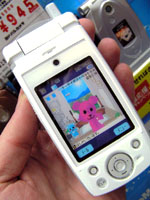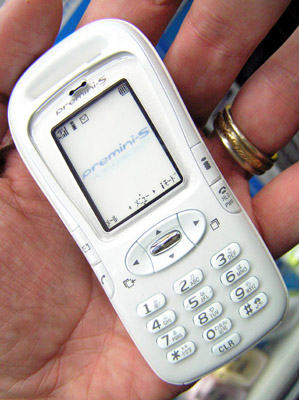New Year Gadget Shopping: Cell Phones that Look Like iPods
 One of the best things about having a few days off over the holiday season in Tokyo is having time to wander casually through Akihabara and check out the latest gadgets. 2005 is shaping up as a showdown year for music-enabled portable devices and I couldn’t help but notice how DoCoMo’s new 3G handset, the SH901ic by Sharp, really does seem to have at least a slight style similarity to the iPod. As the network speed increases — and with flat-rate packet costs and improved handset technology — critical mass adoption by mainstream users buying even more data seems to be at hand. As competition increases, how will carriers, handset makers and content providers adapt their offerings over the coming year?
One of the best things about having a few days off over the holiday season in Tokyo is having time to wander casually through Akihabara and check out the latest gadgets. 2005 is shaping up as a showdown year for music-enabled portable devices and I couldn’t help but notice how DoCoMo’s new 3G handset, the SH901ic by Sharp, really does seem to have at least a slight style similarity to the iPod. As the network speed increases — and with flat-rate packet costs and improved handset technology — critical mass adoption by mainstream users buying even more data seems to be at hand. As competition increases, how will carriers, handset makers and content providers adapt their offerings over the coming year?
While it remains to be seen exactly what kind of applications and services will hit the streets, it has become increasingly clear that a race is on. Having both KDDI and Vodafone launch fixed-line access to content for mobile devices in Q42004 shows, at least in the mid-term, they are ramping up the business model to deliver larger-size files to end users. At any rate, WWJ subscribers login to get a little crystal-ball gazing for the coming year — and some very cool Akiba gadget photos.
 While it may be a new year, the keitai biz remains the same. The carriers are clearly concerned about churn and soon-to-be-enforced number portability and customers have plenty of choice in this marketplace. Improving network speeds has been a continuous process and the latest hype surrounding WiMax and Super 3G just shows that all players are looking forward to offering a bigger pipe.
While it may be a new year, the keitai biz remains the same. The carriers are clearly concerned about churn and soon-to-be-enforced number portability and customers have plenty of choice in this marketplace. Improving network speeds has been a continuous process and the latest hype surrounding WiMax and Super 3G just shows that all players are looking forward to offering a bigger pipe.
With W-CDMA’s proposed software upgrade to the HSDPA revision, we should see DoCoMo handsets on the street by the end of 2005 that will have 3-Mbps connectivity. While sourcing (and selling) handsets to the international market becomes a critical matter of cost per unit, reflecting economies of scale, the recent Super 3G announcement for a global standard should come as no surprise to industry watchers.
 The Japanese handset makers were really under the gun in 2004 and that pressure will continue and likely increase in 2005 as they pursue more overseas deals. While Nokia, Motorola and Samsung have the capacity to fill massive orders, the OEMs in Japan have struggled to meet delivery schedules for their existing customer base much less deal with new orders from Europe or elsewhere.
The Japanese handset makers were really under the gun in 2004 and that pressure will continue and likely increase in 2005 as they pursue more overseas deals. While Nokia, Motorola and Samsung have the capacity to fill massive orders, the OEMs in Japan have struggled to meet delivery schedules for their existing customer base much less deal with new orders from Europe or elsewhere.
However, Japanese makers continue to come up with innovative designs and functions (which has always been their strength); perhaps one of the bigger surprises from 2004 was the Sony Ericsson PreminiS, a palm-size device that does Web and mail but lacks a camera. It sold very well here since its July 1 launch.
From built-in micro hard drives to satellite receivers and embedded IC chips for e-commerce, the makers are clearly in hyper-drive. A detailed look at the market here would make a perfect case study on the topic of competition driving innovation. Typically, the final critical piece of the puzzle will be content and service offering as icing on the cake!
 The end-game is all about the data that streams through all that 3G infrastructure into the customers’ hands. As we have seen in 2004 and earlier, the mobile Web is following the fixed-line PC Web’s path evolving from simple text and images to multimedia audio and video. While it’s a somewhat predictable evolution, the real difference of course is in the end-users’ environment. To quote Rule No. 1 from HP Bazaar: “The Game is Outside.”
The end-game is all about the data that streams through all that 3G infrastructure into the customers’ hands. As we have seen in 2004 and earlier, the mobile Web is following the fixed-line PC Web’s path evolving from simple text and images to multimedia audio and video. While it’s a somewhat predictable evolution, the real difference of course is in the end-users’ environment. To quote Rule No. 1 from HP Bazaar: “The Game is Outside.”
In other words, content, application and service providers who can best tailor their offerings to suit user needs in the mobile environment will ultimately be the most successful. With faster networks, and more sophisticated devices, the opportunities for generating revenue with mobile data are only increasing.
All of the above is easier said than done but it will be very interesting to see what will happen as disruptive devices and competing offerings enter Japan’s market (iPod is here!) and indeed how the established mobile players at all levels react.
It seems that borrowing certain function and design ideas from another platform is not such a bad idea!
— Ken Gai

